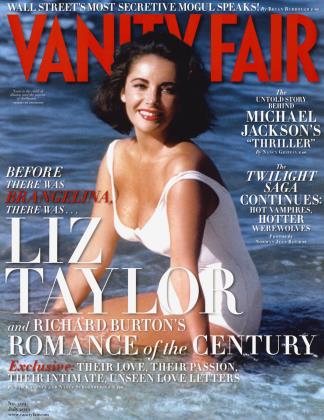Sign In to Your Account
Subscribers have complete access to the archive.
Sign In Not a Subscriber?Join NowCONTRIBUTORS
In “What’s Eating Steve Cohen?” (page 98), special correspondent Bryan Burrough profiles one of the world’s most successful—and most private—hedge-fund managers. “This is only the second set of interviews Cohen has given in 30 years,” Burrough says. “It took nearly four months of negotiations to make it happen. After all that, I found, to my surprise, that he is far less pretentious, and far less guarded, than most of the Masters of the Universe I’ve interviewed.” Burrough is currently researching a book on the major American underground movements of the 1970s.
Before traveling to Los Angeles to photograph the young women of The Twilight Saga: Eclipse (“ Twilight s Blood Sisters,” page 92), contributing photographer Norman Jean Roy took to the Conde Nast archives to find inspiration. “I wanted to do something classic, sexy, sophisticated, and timeless,” he says. At the shoot, one of his favorites among the “supematurals” (their characters are all either vampires or werewolves—no humans allowed) was Dakota Fanning. “I’ve photographed Dakota many times, and she always stands out,” says Roy, pictured here with his sons, Zach and Ethan.
At first, Elizabeth Taylor declined to cooperate with V.F. contributing editor Sam Kashner and Nancy Schoenberger on their book Furious Love: Elizabeth Taylor, Richard Burton, and the Marriage of the Century (excerpted beginning on page 126). “She’s very private about her life with Richard,” explains Schoenberger, a biographer and poet. “But when she was told that a young drama student thought the Burton she had been married to was Tim Burton, she changed her mind. It convinced her that Richard was in danger of being forgotten. For us, reading Burton’s letters and diaries conjured up a ghost—at times playful and teasing, at times passionate and soulful.”
Spotlighting fellow writer Vendela Vida for V.F. (“La Dolce Vida,” page 91) proved a pleasant distraction for the prolific American novelist Meg Wolitzer, who has been at work on her new book, The Uncoupling (to be published next spring by Riverhead). “I love reading fiction while I’m in the middle of writing a book,” says Wolitzer. “Even on the worst, most hideously unproductive day, you can still think Yes! when you read a good line—even if it’s not your own.” Wolitzer’s novels include The Wife, The Position, The Ten-Year Nap, and This Is Your Life, which Nora Ephron (along with her sister Delia) adapted for her 1992 directorial debut.
In 1983, as a Life-magazine reporter, Nancy Griffin spent several days on the set of Michael Jackson’s “Thriller,” and in “The ‘Thriller’ Diaries” (page 60) she chronicles the making of the iconic music video. “This was a time when Michael was still creatively free,” Griffin says. “There weren’t dozens of handlers and minions and bodyguards around him. He was accessible, this lone little guy that you could go up to and talk to. I think after ‘Thriller’ that was all gone.” Griffin has written the introduction to a book of Douglas Kirkland’s behind5 the-scenes photographs from “Thriller,” to be published in November by Filipacchi.
Online design editor Hamish Robertson views each day as an experiment in delivering content to readers in the most lucid, aesthetically pleasing way possible. He oversees the design not only of VEcom but also of the magazine’s iPad edition, which debuted with the June 2010 issue. “Sometimes I feel like a lab technician, only I don’t have to wear a white coat,” says Robertson, a graduate of the Edinburgh College of Art, who moved from England to New York seven years ago. As for the uncertain future of digital media, he says, “It’s reassuring that no one seems to know all the answers. It wouldn’t be as much fun if we did.”
 View Full Issue
View Full Issue






Subscribers have complete access to the archive.
Sign In Not a Subscriber?Join Now